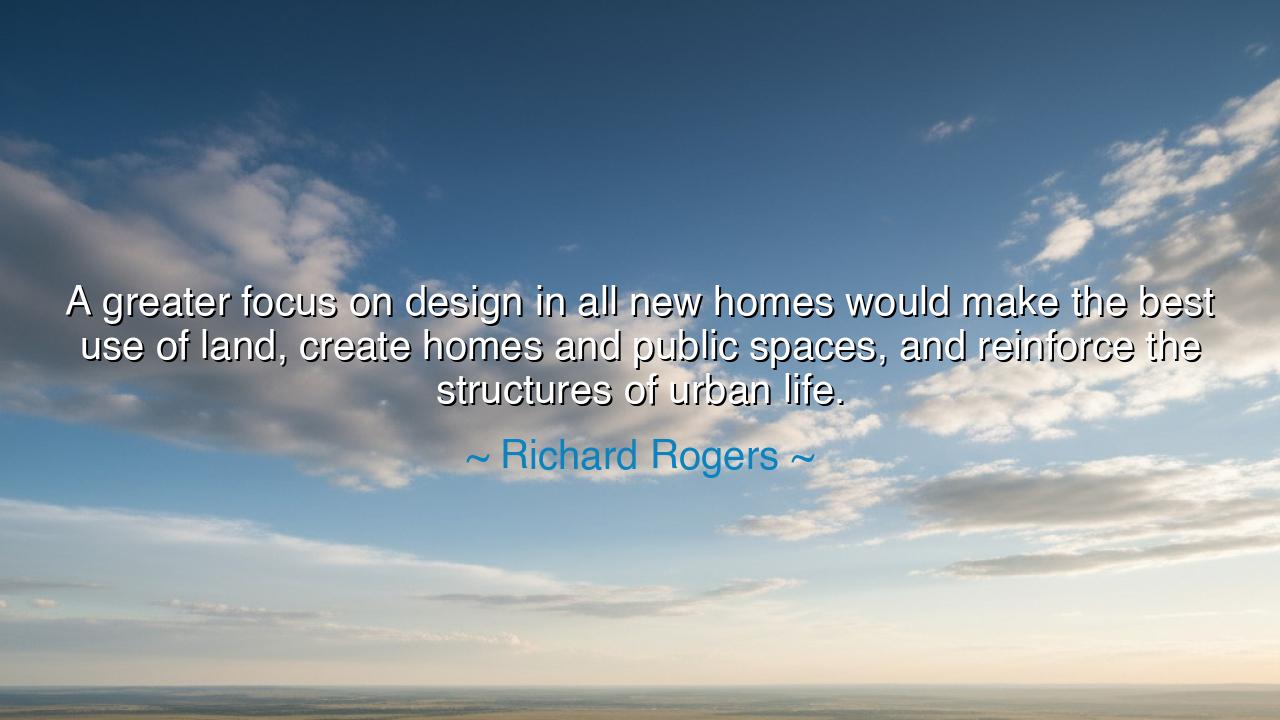
A greater focus on design in all new homes would make the best
A greater focus on design in all new homes would make the best use of land, create homes and public spaces, and reinforce the structures of urban life.






“A greater focus on design in all new homes would make the best use of land, create homes and public spaces, and reinforce the structures of urban life.” Thus spoke Richard Rogers, the visionary architect who saw cities not as mere gatherings of buildings, but as living organisms—breathing, growing, and shaped by the wisdom of design. His words are not simply about architecture, but about the art of living itself. For what is design, if not the conscious effort to harmonize beauty, function, and human spirit? Rogers’ call for a greater focus on design is a call for civilization to remember that how we build reflects how we think, and how we think determines how we live.
In the modern age, cities too often rise without soul—structures stacked upon one another, built in haste, without rhythm or reverence for the people who dwell within them. Rogers saw this and lamented it. He believed that when we neglect design, we neglect humanity itself. The home, in his vision, was not only shelter, but sanctuary—a place that nurtures identity, community, and connection. To design homes and public spaces with intention is to design the fabric of urban life—a fabric that either unites or divides, uplifts or suffocates. When we build without thought, we create loneliness; when we build with wisdom, we create belonging.
The ancients, whom Rogers in spirit echoed, understood this sacred balance. The Greeks, in their city of Athens, placed temples not at random, but in harmony with the sun, the hills, and the sea. The Romans, in their mastery of civic design, wove the forum, the bath, and the garden into the rhythm of everyday life, ensuring that private and public spaces served one another. To them, the city was not a machine for living, but a body—its roads like veins, its squares like hearts, its temples like the soul. Rogers, too, sought to restore this balance in our time, calling for cities where design uplifts the human experience, rather than enslaving it to profit and haste.
Consider the rebirth of Barcelona after its long years of neglect under dictatorship. When democracy returned, its leaders, guided by architects inspired by Rogers’ ideals, placed design at the center of their renewal. They opened public plazas where once there were walls, built housing that breathed light and air, and gave beauty back to the people. The result was not merely better buildings—it was a better life. The city, once weary and grey, became vibrant again, because its spaces were shaped for human joy, not mere survival. This, Rogers would say, is what happens when design serves humanity: the spirit of the city awakens.
But Rogers’ wisdom extends beyond architecture—it touches the moral foundation of society. To make the best use of land is not only a matter of efficiency; it is a matter of stewardship. The earth is finite, and every stone we place upon it should serve not just the present, but the generations to come. When we waste land, we rob the future; when we build with care, we give the future roots. And when we design homes and cities that bring people together, we reinforce the unseen structures of community—trust, compassion, and shared identity.
There is also a spiritual dimension to his teaching. To design well is to participate in creation itself. It is to recognize that human hands, guided by imagination and respect, can shape not chaos, but harmony. Every building, every square, every home becomes a testament to the values of its builders. A city designed with grace teaches its citizens grace. A city designed for division breeds alienation. Thus, design is not neutral—it is a form of ethics made visible.
Let the lesson be this: what we build shapes who we become. Each person, whether architect or inhabitant, must treat their environment as a living covenant. If you are to build, build for connection. If you are to design, design for dignity. Plant trees where there is emptiness, open courtyards where there are walls, and bring light where there is shadow. Remember that a home is not only a roof over one’s head, but a place where one’s soul finds room to grow.
In the end, Richard Rogers’ words are a hymn to the union of humanity and habitat. He calls us to see design not as decoration, but as destiny. When we shape the world with wisdom, it in turn shapes us toward wisdom. When we give thought to the smallest space, we honor the vastness of human life. And so, as the ancients built temples aligned with the stars, let us build homes aligned with the heart—so that every street, every square, every dwelling becomes a living testament to what we truly value: beauty, balance, and belonging.






AAdministratorAdministrator
Welcome, honored guests. Please leave a comment, we will respond soon